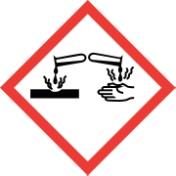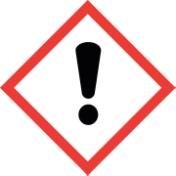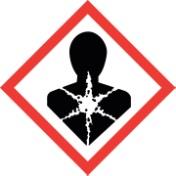Vanadium.evraz.com




Safety Data Sheet
1. Identification
1.1. Product identifier
Product Identity
Vanadyl Sulfate Solution
Alternate Names
Vanadyl Sulfate Solution
1.2. Relevant identified uses of the substance or mixture and uses advised against
Intended use
See Technical Data Sheet.
Application Method
See Technical Data Sheet.
1.3. Details of the supplier of the safety data sheet
Company Name:
EVRAZ Stratcor, Inc.
EVRAZ Stratcor, Inc.
4285 Malvern Road
200 Randolph Drive
Hot Springs, Arkansas 71901; U.S.A
Chicago, Illinois 60601; U.S.A
(Company Identification)
(Inquiry Department)
Telephone:
Website:
www.evrazstratcor.com
www.evrazstratcor.com
Emergency
24 hour Emergency Telephone No.
NATIONAL RESPONSE CENTER: +1-800-424-8802 CHEMTREC U.S. and CANADA: +1-800-424-9300 CHEMTREC International: +1-202-483-7616 (Collect)
2. Hazard(s) identification
2.1. Classification of the substance or mixture
Met. Corr. 1;H290
May be corrosive to metals.
Acute Tox. 4;H302
Harmful if swallowed.
Skin Irrit. 2;H315
Causes skin irritation.
Causes serious eye damage.
Suspected of damaging fertility or the unborn child.
2.2. Label elements
Using the Toxicity Data listed in section 11 and 12 the product is labeled as follows.
Signal Word: Danger
Hazard Statements:
H290 May be corrosive to metals.
H302 Harmful if swallowed.
H315 Causes skin irritation.
H318 Causes serious eye damage.
H361 Suspected of damaging fertility or the unborn child.
P201 Obtain special instructions before use.
P202 Do not handle until all safety precautions have been read and understood.
P234 Keep only in original container.
Vanadyl Sulfate Solution r0
Page 1 of 8
SDS Revision Date: 09/28/2015

Safety Data Sheet
P264 Wash thoroughly after handling.
P270 Do not eat, drink or smoke when using this product.
P280 Wear protective gloves / eye protection / face protection.
[Response]:
P301+312 IF SWALLOWED: Call a POISON CENTER or doctor / physician if you feel unwell.
P302+352 IF ON SKIN: Wash with plenty of soap and water.
P305+351+338 IF IN EYES: Rinse cautiously with water for several minutes. Remove contact lenses if present and easy to do - continue rinsing.
P308+313 IF exposed or concerned: Get medical advice / attention.
P310 Immediately call a POISON CENTER or doctor / physician.
P321 Specific treatment (see information on this label).
P330 Rinse mouth.
P332+313 If skin irritation occurs: Get medical advice / attention.
P362 Take off contaminated clothing and wash before reuse.
[Storage]:
P405 Store locked up.
P406 Store in a corrosive resistant / container with a resistant inner liner.
[Disposal]:
P501 Dispose of contents / container in accordance with local / national regulations.
3. Composition/information on ingredients
This product contains the following substances that present a hazard within the meaning of the relevant State and Federal Hazardous Substances regulations.
Ingredient/Chemical Designations
GHS Classification
Vanadyl sulfate.
Met. Corr. 1;H290
CAS Number: 0027774-13-6
Acute Tox. 4;H302
Skin Irrit. 2;H315
Eye Irrit. 2;H319
Repr. 2 (Oral);H361
Aquatic Chronic 3;H412
Sulfuric acid
Skin Corr. 1A;H314 (> 15%)
CAS Number: 0007664-93-9
In accordance with paragraph (i) of §1910.1200, the specific chemical identity and/or exact percentage (concentration) of composition has been withheld as a trade secret. [1] Substance classified with a health or environmental hazard. [2] Substance with a workplace exposure limit. [3] PBT-substance or vPvB-substance. *The full texts of the phrases are shown in Section 16.
4. First aid measures
4.1. Description of first aid measures
In all cases of doubt, or when symptoms persist, seek medical attention. Never give anything by mouth to an unconscious person.
Inhalation
Remove to fresh air, keep patient warm and at rest. If breathing is irregular or stopped, give artificial respiration. If unconscious place in the recovery position and obtain immediate medical attention. Give nothing by mouth.
Causes serious eye damage. Irrigate copiously with clean water for at least 15 minutes, holding the eyelids apart. Remove contact lenses, if present and easy to do. Continue rinsing. Seek medical attention.
Remove contaminated clothing. Wash skin thoroughly with soap and water or use a recognized skin cleanser.
Ingestion
Do NOT induce vomiting. Rinse mouth and slowly drink several glasses of water. Call a physician. Do NOT give anything by mouth to an unconscious or convulsing person.
4.2. Most important symptoms and effects, both acute and delayed
Overview
Eye Contact Redness, swelling, pain, and flood of tears. Possible chemical burns and corneal damage. Skin Contact Irritation with burning, reddening, and itching. Dermatitis.
Vanadyl Sulfate Solution r0
Page 2 of 8
SDS Revision Date: 09/28/2015

Safety Data Sheet
Inhalation Breathing difficulty, irritation of mucous membranes, coughing, acute reaction to vanadium salts and sulfuric-acid mists. Ingestion Chemical and irritation of the intestinal tract. Abdominal discomfort, vomiting, diarrhea, and spasms. See section 2 for further details.
Causes serious eye damage.
Causes skin irritation.
Ingestion
Harmful if swallowed.
5. Fire-fighting measures
5.1. Extinguishing media
Use media suitable to the surrounding fire, such as water fog, dry chemical, foam, and carbon dioxide.
5.2. Special hazards arising from the substance or mixture
Wear appropriate chemically-protective equipment, such as gloves, a faceshield, goggles, and suitable body protection (see Section 8). Level B gear recommended for large releases.
Hazardous decomposition: If heated or involved in a fire, toxic and irritating fumes of sulfur oxides and vanadium oxides may be formed.
Prevent spilled product from entering drains, sewers, waterways, and soil.
Keep only in original container.
5.3. Advice for fire-fighters
Wear proper chemically resistant protective equipment and self-contained breathing apparatus (SCBA) operated in positive-pressure mode.
This product may release flammable hydrogen gas on contact with many common metals, which may signifi-cantly contribute to the risk of fire and explosion. Fire may result in toxic and irritating fumes.
Move container from fire area if it can be done without risk. Use water spray to keep fire exposed containers cool. Keep run-off water out of sewers and water sources.
ERG Guide No.
6. Accidental release measures
6.1. Personal precautions, protective equipment and emergency procedures
Put on appropriate personal protective equipment (see section 8).
Wear appropriate chemically-protective equipment, such as gloves, a face shield, goggles, and suitable body protection (see Section 8). Level B gear recommended for large releases.
6.2. Environmental precautions
Prevent spilled product from entering drains, sewers, waterways, and soil.
Do not allow spills to enter drains or waterways.
Use good personal hygiene practices. Wash hands before eating, drinking, smoking or using toilet. Promptly remove soiled clothing and wash thoroughly before reuse.
6.3. Methods and material for containment and cleaning up
Wear appropriate chemically-protective equipment, such as gloves, a face shield, goggles, and suitable body protection (see Section 8). Level B gear recommended for large releases.
Ventilate area of release. Stop leak if possible without risk. Do not touch spilled material. Dike far ahead of spill with inert diking materials. For small spills, neutralize with soda ash, absorb spill with inert, non-combustible material such as clay then place in suitable containers. For large spills, contain spill with inert, noncombustible absorbent material such as clay or earth. Remove spilled liquid with pumps into suitable containers, or absorb with dry clay and shovel into polyethylene or plastic containers. Steel or aluminum containers may react with the product and dissolve. Wash thoroughly after dealing with a spillage
7. Handling and storage
7.1. Precautions for safe handling
Always wear chemically-protective equipment during hand-ling. Use in a well-ventilated area. Do not inhale vapors or mists. Do not allow contact with eyes, skin and clothing. Process and handling equipment must be resistant to dilute acidic solutions. Keep away from metals, bases and other incompatible materials. Wash thoroughly after handling material.
See section 2 for further details. - [Prevention]:
Vanadyl Sulfate Solution r0
Page 3 of 8
SDS Revision Date: 09/28/2015

Safety Data Sheet
7.2. Conditions for safe storage, including any incompatibilities
Handle containers carefully to prevent damage and spillage.
Store in closed, suitable containers located in a cool, dry, well-ventilated area. Store away from incompatibles.
Incompatible materials: Acids react with most metals to release hydrogen gas which can form explosive mixtures in air. Water, alkaline solutions, metals, metal powder, carbides, chlorates, fuminates, nitrates, picrates, strong oxidizers, reducers, or combustible organics. Hazardous gases may evolve on contact with chemicals such as cyanides, sulfides, and carbides.
See section 2 for further details. - [Storage]:
7.3. Specific end use(s)
No data available.
8. Exposure controls and personal protection
8.1. Control parameters
Exposure
Ingredient
TWA: 0.2 mg/m3 A1, 1, Revised 2004,
No Established Limit
Vanadyl sulfate.
No Established Limit
No Established Limit
0.05 mg/m3 15-min ceiling for vanadium compounds 0.05 mg/m3 for V2O5 TLV TWA
No Established Limit
Carcinogen Data
Ingredient
Select Carcinogen: No
Known: Yes; Suspected: No
Group 1: Yes; Group 2a: No; Group 2b: No; Group 3: No; Group 4: No;
Vanadyl sulfate.
Select Carcinogen: No
Known: No; Suspected: No
Group 1: No; Group 2a: No; Group 2b: No; Group 3: No; Group 4: No;
8.2. Exposure controls
Respiratory
Use respirators approved by NIOSH/MSHA; use SAR for oxygen-deficient atmosphere.
Use chemical-splash goggles and a full face shield or mask.
Wear chemically-protective clothing. Use chemically-protective gloves.
Engineering
Provide adequate ventilation. Where reasonably practicable this should be achieved by the use of local exhaust
Controls
ventilation and good general extraction. If these are not sufficient to maintain concentrations of particulates and any vapor below occupational exposure limits suitable respiratory protection must be worn.
Other Work
Do not inhale vapors or mists. Do not allow contact with eyes, skin and clothing. Do not eat, drink, smoke or use
Practices
cosmetics while working with this product. Thoroughly wash at the end of each work shift. Immediately remove any clothing that becomes contaminated and launder before re-use. Contaminated shoes should be destroyed. Use good personal hygiene practices. Wash hands before eating, drinking, smoking or using toilet. Promptly remove soiled clothing and wash thoroughly before reuse.
See section 2 for further details. - [Prevention]:
Vanadyl Sulfate Solution r0
Page 4 of 8
SDS Revision Date: 09/28/2015

Safety Data Sheet
9. Physical and chemical properties
Appearance
Dark Blue Liquid
Odor threshold
Melting point / freezing point
Initial boiling point and boiling range
120°C. (248°F).
Flash Point
Evaporation rate (Ether = 1)
Flammability (solid, gas)
Upper/lower flammability or explosive limits
Lower Explosive Limit: Not applicable
Upper Explosive Limit: Not applicable
Vapor pressure (Pa)
Vapor Density
Specific Gravity
Solubility in Water
Miscible with water at all concentrations.
Partition coefficient n-octanol/water (Log Kow)
Auto-ignition temperature
Decomposition temperature
Viscosity (cSt)
Oxidizing Properties
May act as a catalyst in certain chemical environments.
9.2. Other information
No other relevant information.
10. Stability and reactivity
10.1. Reactivity
This product may release flammable hydrogen gas on contact with many common metals
10.2. Chemical stability
Stable under normal circumstances.
10.3. Possibility of hazardous reactions
Reacts with some bases.
10.4. Conditions to avoid
Keep away from extreme heat and extreme cold.
10.5. Incompatible materials
Acids react with most metals to release hydrogen gas which can form explosive mixtures in air. Water, alkaline solutions, metals, metal powder, carbides, chlorates, fuminates, nitrates, picrates, strong oxidizers, reducers, or combustible organics. Hazardous gases may evolve on contact with chemicals such as cyanides, sulfides, and carbides.
10.6. Hazardous decomposition products
If heated or involved in a fire, toxic and irritating fumes of sulfur oxides and vanadium oxides may be formed.
11. Toxicological information
Acute toxicity
Ingredient
Oral LD50,
Skin LD50,
Inhalation
Inhalation
Inhalation
Vapor LC50, Dust/Mist LC50,
Gas LC50,
mg/L/4hr
mg/L/4hr
Vanadyl sulfate. - (27774-13-6)
Sulfuric acid - (7664-93-9)
Vanadyl Sulfate Solution r0
Page 5 of 8
SDS Revision Date: 09/28/2015
Safety Data Sheet
Note: When no route specific LD50 data is available for an acute toxin, the converted acute toxicity point estimate was used in the calculation of the product's ATE (Acute Toxicity Estimate).
Category
Hazard Description
Acute toxicity (oral)
Harmful if swallowed.
Acute toxicity (dermal)
Acute toxicity (inhalation)
Skin corrosion/irritation
Causes skin irritation.
Serious eye damage/irritation
Causes serious eye damage.
Respiratory sensitization
Skin sensitization
Germ cell mutagenicity
Reproductive toxicity
Suspected of damaging fertility or the unborn child.
STOT-single exposure
STOT-repeated exposure
Aspiration hazard
12. Ecological information
12.1. Toxicity
Components of this product can be harmful or fatal to aquatic organisms. The ecotoxic effects of the product itself have not been fully investigated. This material will lower the pH of any environment.
Aquatic Ecotoxicity
96 hr LC50 fish,
48 hr EC50 crustacea,
ErC50 algae,
Ingredient
Vanadyl sulfate. - (27774-13-6)
Sulfuric acid - (7664-93-9)
42.00, Gambusia affinis
42.50, Pandalus montagui
12.2. Persistence and degradability
The components of this product will react with other sub-stances or be degraded over time into other inorganic compounds.
12.3. Bioaccumulative potential
12.4. Mobility in soil
No data available.
12.5. Results of PBT and vPvB assessment
This product contains no PBT/vPvB chemicals.
12.6. Other adverse effects
No data available.
13. Disposal considerations
13.1. Waste treatment methods
This product must be disposed of as a hazardous waste based on its harmful and irritating properties. Disposal should be made in compliance with Federal, state, and local environmental regulations. Empty containers must be disposed of as a hazardous waste based on its harmful and irritating properties. Disposal should be made in compliance with Federal, state, and local regulations.
Vanadyl Sulfate Solution r0
Page 6 of 8
SDS Revision Date: 09/28/2015
Safety Data Sheet
14. Transport information
DOT (Domestic Surface Transportation)
IMO / IMDG (Ocean Transportation)
ICAO/IATA
14.1. UN number
14.2. UN proper
UN2922, Corrosive liquids, toxic, n.o.s.,
Corrosive liquids, toxic, n.o.s.,
Corrosive liquids, toxic, n.o.s.,
shipping name
(Contains sulfuric acid, vanadyl sulfate, 8, I
(Contains sulfuric acid, vanadyl sulfate) (Contains sulfuric acid, vanadyl
14.3. Transport
DOT Hazard Class: 8
Air Class: 8
hazard class(es)
14.4. Packing
14.5. Environmental hazards
Marine Pollutant: ; yes
14.6. Special precautions for user
No further information
15. Regulatory information
Regulatory Overview
The regulatory data in Section 15 is not intended to be all-inclusive, only selected regulations are represented.
Toxic Substance Control Act All components of this material are either listed or exempt from listing on the TSCA Inventory.
( TSCA)
WHMIS Classification
US EPA Tier II Hazards
Sudden Release of Pressure: No
Reactive: Yes
Immediate (Acute): Yes
Delayed (Chronic): No
Note: Strong inorganic acid mists containing sulfuric acid are listed on the California Proposition 65 Carcinogen List. [Sulfuric acid, in and of itself,
is not listed under Proposition 65. However, if one has sulfuric acid, which through its intended use generates an acid mist that in turn contains
sulfuric acid that would meet the listing. The term "strong" does not refer to the concentration of the acid, but rather the strength of the acid. The
basis for the listing of strong inorganic acid mists containing sulfuric acid was the formal identification by the National Toxicology Program (NTP), in
its Ninth Report on Carcinogens, that this chemical mixture is "known to be a human carcinogen." (Public notice available at
http://www.oehha.ca.gov/prop65/CRNR_notices/admin_listing/intent_to_list/noil19b4.html.) ]
EPCRA 311/312 Chemicals and RQs (lbs):
Sulfuric acid ( 1,000.00)
Vanadyl sulfate. ( 1,000.00)
EPCRA 302 Extremely Hazardous:
EPCRA 313 Toxic Chemicals:
Vanadyl sulfate.
Proposition 65 - Carcinogens (>0.0%):
To the best of our knowledge, there are no chemicals at levels which require reporting under this statute.
Proposition 65 - Developmental Toxins (>0.0%):
To the best of our knowledge, there are no chemicals at levels which require reporting under this statute.
Proposition 65 - Female Repro Toxins (>0.0%):
To the best of our knowledge, there are no chemicals at levels which require reporting under this statute.
Proposition 65 - Male Repro Toxins (>0.0%):
To the best of our knowledge, there are no chemicals at levels which require reporting under this statute.
New Jersey RTK Substances (>1%):
Vanadyl sulfate.
Vanadyl Sulfate Solution r0
Page 7 of 8
SDS Revision Date: 09/28/2015
Safety Data Sheet
Pennsylvania RTK Substances (>1%):
Vanadyl sulfate.
16. Other information
The information and recommendations contained herein are based upon data believed to be correct. However, no guarantee or warranty of any kind, expressed or implied, is made with respect to the information contained herein. We accept no responsibility and disclaim all liability for any harmful effects which may be caused by exposure to our products. Customers/users of this product must comply with all applicable health and safety laws, regulations, and orders.
The full text of the phrases appearing in section 3 is:
H290 May be corrosive to metals.
H302 Harmful if swallowed.
H314 Causes severe skin burns and eye damage.
H315 Causes skin irritation.
H319 Causes serious eye irritation.
H361 Suspected of damaging fertility or the unborn child.
H412 Harmful to aquatic life with long lasting effects.
EVRAZ Stratcor, Inc. believes that the data on this sheet are correct as of the effective date and that the opinions given reflect those of qualified experts. Since EVRAZ Stratcor cannot control the product or its use, it is the user's responsibility to use the product safely. The data on this sheet apply only to products sold by corporate subsidiaries of EVRAZ Stratcor and may not apply to products sold by others.
Vanadyl Sulfate Solution r0
Page 8 of 8
SDS Revision Date: 09/28/2015
Source: http://vanadium.evraz.com/upload/Vanadyl%20Sulfate%20Solution%20r0.pdf
Reviews in Gynaecological Practice xxx (2004) xxx–xxx Cryopreservation of two pronuclear stage zygotes Yasser OriefNikos Safaa Department of Obstetrics and Gynecology, Shatby University hospital, Alexandria University, Egypt Laboratory of Reproductive Physiology, Faculty of Medicine, Demokritus University of Thrace, Dragana, 68100 Alexandroupolis, Greece Department of Obstetrics and Gynecology, Medical University of Lubick 23538, Germany
Efecto a nivel celular y molecular de agentes antitumoralesCellular and molecular effect of antitumor agents Silvia Ramírez-Sánchez*, Gildardo Rivera* La biología celular y molecular es un área de investigación de gran impacto y rápido creci-miento, la cual se ha convertido en un punto esencial para el desarrollo de nuevos agentes quimioterapéuticos con niveles bajos de toxicidad, particularmente para el cáncer. Aunque la era de la quimioterapia comenzó en los años 40, actualmente es necesario desarrollar nuevas terapias antitumorales que permitan tener un tratamiento apropiado para cada paciente y tipo de tumor, siendo necesaria la identificación de componentes celulares y moleculares involucrados en los procesos de carcinogénesis, para el desarrollo de agentes quimioterapéu-ticos que intervengan en la restauración o destrucción selectiva de las células cancerígenas. Actualmente, se ha demostrado que ciertos medicamentos, como los antibióticos (tetracic-linas, sulfonamidas y b-lactamas) y otros compuestos químicos (quinoxalinas) que son uti-








